Thermalright Ultra 120 Extreme: Is More Better?
by Wesley Fink on March 7, 2007 12:05 AM EST- Posted in
- Cases/Cooling/PSUs
As testing on the Thermalright Ultra 120 was nearing completion, Thermalright contacted us and asked if we would like to take a look at a new Thermalright cooler that was "even better than the Ultra 120". With the Ultra 120 rising to the top of our heatpipe tower performance charts, the answer was a definite "Yes".
A few days later a package arrived from Taiwan in the stock Thermalright plain brown box. There was not even a new ID on the package for this new cooler, but Thermalright told us it would be called the Thermalright Ultra 120 Extreme. So what is improved on the new Ultra 120 Extreme?
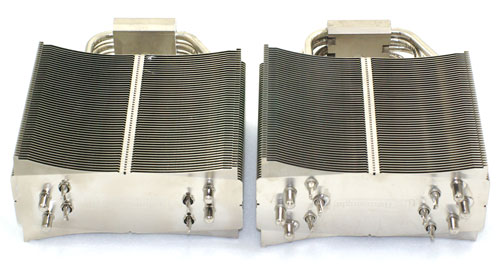
As you can see in the side-by-side comparison with the current Ultra 120, Thermalright has managed to add two more heatpipes to the Ultra 120 Extreme, raising the total heatpipes from four to six. Everything else about the Ultra 120 Extreme seems to be exactly the same as the existing Ultra 120.
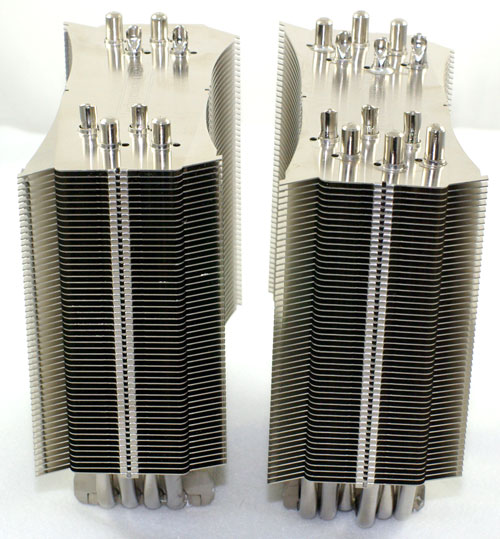
It is always good to see more heatpipes for cooling - particularly in a design that has proven to perform very well as the Ultra 120 has. We wondered, however, exactly how much difference two added heatpipes could make in the performance of the Ultra 120. Was it enough of a difference to justify Thermalright's enthusiasm about the new design?
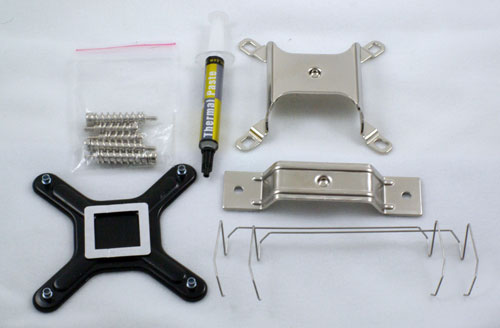
Thermalright also updated the kit with the Ultra 120 Extreme. Where the AM2 adapter is an optional accessory with the Ultra 120 kit, the Socket 775, AM2, and AMD 754/939/940 adapters are all included with the Ultra 120 Extreme.
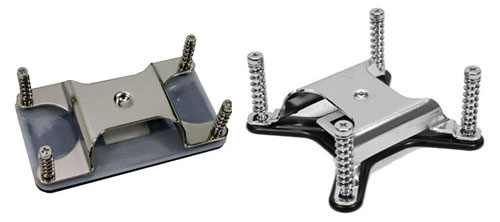
The addition of two extra heatpipes is pretty straightforward. However, the location of the added pipes does create some issues with the Intel socket 775 adapter carried over from the current Ultra 120 kit. The adapter frankly won't fit through the heatpipes in the new design. We actually had to bend the Socket 775 adapter to mount the Ultra 120 Extreme on a Core 2 Duo.
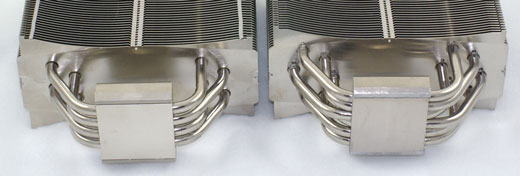
We have alerted Thermalright to the problem, and we sincerely hope they will make modifications to the Socket 775 bracket before shipping the Extreme kits to the retail channel. Those handy with tools will find a way to mount the Ultra 120 Extreme on a Socket 775, but most users will want an adapter that is easier to work with.

To isolate just the impact of the Extreme modification we tested with the same Scythe S-Flex fan used in the Thermalright Ultra 120 review. This excellent fan moves a lot of air, but still keeps noise low with the Sony developed Fluid Dynamic Bearing on the fan motor.
A few days later a package arrived from Taiwan in the stock Thermalright plain brown box. There was not even a new ID on the package for this new cooler, but Thermalright told us it would be called the Thermalright Ultra 120 Extreme. So what is improved on the new Ultra 120 Extreme?

As you can see in the side-by-side comparison with the current Ultra 120, Thermalright has managed to add two more heatpipes to the Ultra 120 Extreme, raising the total heatpipes from four to six. Everything else about the Ultra 120 Extreme seems to be exactly the same as the existing Ultra 120.

It is always good to see more heatpipes for cooling - particularly in a design that has proven to perform very well as the Ultra 120 has. We wondered, however, exactly how much difference two added heatpipes could make in the performance of the Ultra 120. Was it enough of a difference to justify Thermalright's enthusiasm about the new design?

Thermalright also updated the kit with the Ultra 120 Extreme. Where the AM2 adapter is an optional accessory with the Ultra 120 kit, the Socket 775, AM2, and AMD 754/939/940 adapters are all included with the Ultra 120 Extreme.

The addition of two extra heatpipes is pretty straightforward. However, the location of the added pipes does create some issues with the Intel socket 775 adapter carried over from the current Ultra 120 kit. The adapter frankly won't fit through the heatpipes in the new design. We actually had to bend the Socket 775 adapter to mount the Ultra 120 Extreme on a Core 2 Duo.

We have alerted Thermalright to the problem, and we sincerely hope they will make modifications to the Socket 775 bracket before shipping the Extreme kits to the retail channel. Those handy with tools will find a way to mount the Ultra 120 Extreme on a Socket 775, but most users will want an adapter that is easier to work with.

To isolate just the impact of the Extreme modification we tested with the same Scythe S-Flex fan used in the Thermalright Ultra 120 review. This excellent fan moves a lot of air, but still keeps noise low with the Sony developed Fluid Dynamic Bearing on the fan motor.










54 Comments
View All Comments
PICBoy - Thursday, March 8, 2007 - link
Oops! actually on every table and image the name "PLUS" is used instead of Extreme. My bad, that's all!Spoelie - Wednesday, March 7, 2007 - link
For the quieter power supplies, I'd look at the Seasonic S12+ series, and the Corsair HX series for a higher powered system.Why? That particular Seasonic is by many a reviewsite considered to be one of the quietest around, and starts ramping up the fan around 250w (depending on how much case cooling you have). The corsair is ~2dB louder in the low wattage scale, but only starts ramping up around 300w given the same conditions.
The ramping-up spot is pretty important, for example, before I had a Venice+x850xt and CM RealPower psu, this proved to be a pretty quiet combination. However, once I upgraded to an oc'd denmark+x1950xt, idle power jumped up and the PSU was already ramping up during idle. It only got worse under load, and I couldn't stand the noise at all. I replaced the PSU with a Corsair HX and have yet to actually hear it ramp up, the other TC fans in the system drown out any noise it makes.
A passively cooled mobo is standard these days, and a minimum of case airflow should be considered as well.
Frumious1 - Wednesday, March 7, 2007 - link
Noise and performance tend to be conflicting goals. Sure, you can get a passively cooled motherboard, and with a down-facing PSU fan you can probably go fanless on the CPU (with something like an Ultra 120/120+). You should probably still mount a low RPM case fan, however, as a "good" PSU that doesn't ramp up fan speed is also not going to move a lot of air.The problem is, if you want to overclock all of that silent/fanless stuff becomes much more difficult (if not impossible). 680i motherboards are known to use quite a bit of power, and the chipsets definitely require active cooling if you want to do some real overclocking. Then you get higher CPU temperatures, and without active cooling on the CPU you tend to rapidly increase temperatures until the system crashes/shuts down.
The cooling test bed appears to be configured as a reasonable compromise between extremes. Some people want silence, some people want performance and quiet be damned, but most are just looking to build a reasonably fast and reasonably quiet PC - hopefully without breaking the bank. Besides, as Wes mentions above, SPCR already covers the "silence above all" market quite well. Why go up against them when there's a vast user base that has more moderate needs?
Spoelie - Wednesday, March 7, 2007 - link
The thing is, with the right aftermarket parts, you can have a totally silent pc AND a high performance/overclocked one. There isn't a need for compromise, as long as you don't want to break any world records. I mean, even in this review, they have a core2 duo overclocked to 3.9ghz without any case air flow. I call that pretty high performance.http://www.jaha.be/ashop/?mod=product&cat_id=5...">http://www.jaha.be/ashop/?mod=product&cat_id=5... Thermalright HR05 for the chipset, this is a passive heatsink that dropped my chipset temperature 10°C over the standard HSF combo. Granted, I only have the DFI nForce4, but there are plenty of high performance alternatives for the 680i. Thermalright also has a good passive cooler for scorching hot ram: http://www.jaha.be/ashop/?mod=product&cat_id=5...">http://www.jaha.be/ashop/?mod=product&cat_id=5...
Choose a good case like the Antec P-series, put the silent psu's mentioned earlier in there, change the exhaust fan for a nice 1000rpm nexus/papst, get the reviewed heatsink (or a tuniq/scythe, it's not like i'm a thermalright fan) with another 1000rpm nexus/papst and you're set. All modern gpu standard cooling solutions can be made extremely quiet at idle with some software tweaking, so you'll only hear them when you're gaming. I guarantee the above combination will support heavy overclocking and be extremely quiet at the same time.
Spoelie - Wednesday, March 7, 2007 - link
Hmmm just want to add that you do have a point about the moderate user not going to put all that aftermarket stuff in their pc, so the thing about the differing user bases is right. On the other hand, a moderate user isn't going to provide extra active cooling to overclock (or even have) a 680i.Baked - Wednesday, March 7, 2007 - link
Nice review. Have the Ultra-120 on my C2D system. When I get the chance to get a C2Q, the Ultra-120+ is going in there.nrb - Wednesday, March 7, 2007 - link
...is you need to actually benchmark the Tuniq Tower using the same S-Flex fan.Wesley Fink - Wednesday, March 7, 2007 - link
One more time. If a cooler comes with a fan we test with that fan. We chose the S-Flex because the Ultra 120 and 120+ do NOT come with a fan, and the other fans we had available would not fit the Ultra 120/120+ clips. We may well test 120mm fans in the future, but we do not plan to do cooler reviews using several different aftermarket fans as a routine test procedure. We do our best to test the cooler as shipped.Having said that, it is likely a good idea to compare a few of the top-performing coolers using the same top-performing fan in a separate review. We agree that would be interesting.
PCTechNow - Wednesday, March 7, 2007 - link
Why not go back and test the other coolers with the same fan used in this review? It would at least show if the fan or the cooler is making the difference. Better yet, take the fan off the Tuniq and test with it on the Thermalrights and see what the difference is.dm0r - Wednesday, March 7, 2007 - link
Air cooling is gettin better and quieter this days...good to see a cooler that improves them both.I was choosing tuniq tower for my next desktop system but i liked the Thermalright ultra 120 in Noiseless cooling.Thanks AT for this review.BTW Any results difference between 120 and 120+ in noiseless cooling?